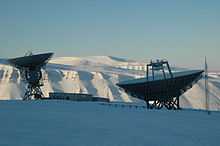EISCAT

EISCAT is an acronym for the European Incoherent Scatter Scientific Association. It operates three incoherent scatter radar systems, at 224 MHz, 931 MHz in Northern Scandinavia and one at 500 MHz on Svalbard, used to study the interaction between the Sun and the Earth as revealed by disturbances in the ionosphere and magnetosphere. At the Ramfjordmoen facility (near Tromsø, Norway), it also operates an ionospheric heater facility, similar to HAARP. Additional receiver stations are located in Sodankylä, Finland, and Kiruna, Sweden. The EISCAT Headquarters are also located in Kiruna.
EISCAT is funded and operated by research institutes and research councils of Norway, Sweden, Finland, Japan, China, the United Kingdom, France and Germany.
In 2008, Doritos embarked upon an "out-of-this-world" advertising campaign, literally beaming a 30-second advertisement for Doritos brand tortilla chips into a solar system 42 light years away. This project is in collaboration with EISCAT Space Centre in Svalbard. The "You Make It, We'll Play It" contest chose the winning advertisement that was transmitted on June 12, 2008. The ad was beamed towards a distant star, within the Ursa Major constellation which is orbited by planets which may harbor life.[1]
History
In 1973, the EISCAT proposal — which was originally planned for France, Germany and the three Nordic countries — seemed moribund. Then, Welsh physicist Granville Beynon became involved and by 1975, the agreement was signed, with the UK as a member. The proposal for UK membership had originally been turned down by the appropriate SRC committee. Beynon, however, persuaded the Board to reverse the decision of the committee and as a result of his efforts, hundreds of European scientists have had the opportunity to use the world's most advanced ionospheric radar.[2]
EISCAT 3D
EISCAT is planning on building a next generation scatter radar capable of providing 3D monitoring of the atmosphere and ionosphere.
In 2008, the European Strategy Forum on Research Infrastructures selected EISCAT 3D for its "Roadmap 2008 for Large-Scale European Research Infrastructures for the next 20–30 years." Production on a modular basis will begin in 2015 and some of the arrays will be extremely large with over 30,000 individual antenna elements.[3]
References
- ↑ Highfield, Roger (7 March 2008). "UK astronomers to broadcast adverts to aliens". The Daily Telegraph. Retrieved 28 January 2011.
- ↑ Williams, Phil (April 1996). "Sir Granville Beynon". Retrieved 28 January 2011.
- ↑ "What is Eiscat 3D?"
External links
| Wikimedia Commons has media related to European Incoherent Scatter Scientific Association. |
Coordinates: 69°35′10.67″N 19°13′28.62″E / 69.5862972°N 19.2246167°E